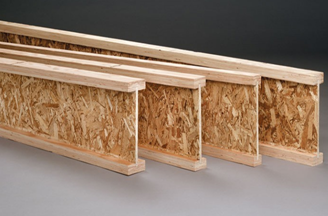Engineered lumber has several benefits as compared to sawn lumber. Also known as engineered wood, it is a man-made wood element that incorporates binding together wood elements with adhesives that are water proof.
Engineered to particular design disciplines, engineered lumber comes in different products, formats and sizes and is tailored for utilization in commercial and residential buildings.
Tried and tested to meet desired standards in National Building Code, it supplies ultimate strength tolerances as compared to solid wood. It is considered to be one of the most economical and green friendly materials available. Trees with smaller diameter are utilized in the manufacture of engineered lumber, thus making use of components that is regarded as waste in traditional logging industry. Several products that manifest this characteristic are laminated veneer lumber, i-joists, and rim board.
engineered beams
LAMINATED VENEER LUMBER: Laminated Veneer Lumber comes from several layers of thin wood fastened by water proof adhesive. This kind of wood is cured with the use of high pressure to come up with a wood product that is stronger, straighter and uniform as compared to sized milled wood.
Just like joists, laminated veneer lumber is less prone to split, twist, shrinkage, check and bow. This is because of its design and the process of manufacturing. This type of wood is available in several widths, lengths, and depths. Laminated veneer wood is tailored to be utilized for spans, beams, and headers carrying heavy loads.
I-JOISTS. These type of engineered lumber were invented in the late 60s, are specifically tailored for use as roofing and floor joists. I-joists are ultimately strong for their weight and size. It varies in depths ranging from 9.25 inches to 28 inches and lengths up to 56 inches. I-joists are designed to maximum its compressible strength to support heavy loads destined for long spans.
I-joists supplements tons of benefits as compared to traditional dimensional lumber. These comprise not twisting, splitting, bowing, or accumulating a crown. This is because of the fact that I-joists are more dimensionally stable as compared to regular wood beams. These engineered i-joists do not shrink. In result, you say goodbye to squeaky floors. Further, i-joists performance to light weight ration, gives freedom for faster construction.
RIM BOARD: Rim board is another type of engineered wood utilized by contractors to ease up construction of buildings and houses. Used as frame of the flooring system, rim board is placed around the perimeter of the floor to surround the joists. The rim board supplies a flat surface allowing either exterior or cladding to construct easily.
This type of engineered wood is made up of large cuts of wood flakes, which is cured using extreme pressure to come up with a product that is install-friendly and easy to handle. Rim board is manufactured in depths that are in coherence with i-joists, taking away extra time and work needed to cut traditional lumber on site. It also decreases the possibility of making mistakes in cutting and measuring.
These engineered wood products are very helpful in flooring and roofing system because it simplify construction and is cost economic. It also provides added strength to your building.

